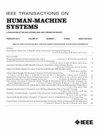Introducing a Passive Shoulder Exoskeleton in a Production Plant: A Longitudinal Observation of Its Effects on Workers
IF 4.4
3区 计算机科学
Q2 COMPUTER SCIENCE, ARTIFICIAL INTELLIGENCE
引用次数: 0
Abstract
Occupational exoskeletons have the potential to prevent work-related musculoskeletal disorders. Their widespread adoption should be promoted by investigating their long-term innocuity, sustained effectiveness, and practicability. This article presents a six-months longitudinal study exploring effects of an arm support exoskeleton (ASE) on six male workers, examining potential side effects, ASE's effectiveness, and its integration into daily work practices. Monthly clinical visits were scheduled to monitor workers’ health. Effectiveness, usability and acceptance metrics were collected at the beginning of the study and after six months. No side effects were found in clinical metrics during the study. Significant reductions, consistent overtime, were observed in shoulder muscle activity (up to 30%) and in effort perception-related metrics (up to 2.4 out of 10 points). Usage time settled around 10% of the monthly work-shift and gradually decreased possibly due to external factors (e.g., social, motivational, and seasonal factors) beyond researchers' control. Results encourage the continuation of similar investigations to strengthen these findings and promote the use of occupational exoskeletons.在生产车间引入被动式肩部外骨骼:纵向观察其对工人的影响
职业外骨骼有可能预防与工作有关的肌肉骨骼疾病。应通过调查它们的长期无害性、持续有效性和实用性来促进它们的广泛采用。本文介绍了一项为期六个月的纵向研究,探讨了手臂支撑外骨骼(ASE)对六名男性工人的影响,检查了潜在的副作用、ASE的有效性及其与日常工作实践的结合。计划每月进行临床检查,以监测工人的健康状况。在研究开始时和六个月后收集有效性、可用性和接受度指标。在研究期间的临床指标中未发现副作用。持续的加班,在肩部肌肉活动(高达30%)和努力感知相关指标(高达2.4分)上观察到显著的减少。使用时间稳定在每月工作班次的10%左右,并可能由于研究人员无法控制的外部因素(如社会,动机和季节性因素)而逐渐减少。结果鼓励继续进行类似的调查,以加强这些发现并促进职业外骨骼的使用。
本文章由计算机程序翻译,如有差异,请以英文原文为准。
求助全文
约1分钟内获得全文
求助全文
来源期刊

IEEE Transactions on Human-Machine Systems
COMPUTER SCIENCE, ARTIFICIAL INTELLIGENCE-COMPUTER SCIENCE, CYBERNETICS
CiteScore
7.10
自引率
11.10%
发文量
136
期刊介绍:
The scope of the IEEE Transactions on Human-Machine Systems includes the fields of human machine systems. It covers human systems and human organizational interactions including cognitive ergonomics, system test and evaluation, and human information processing concerns in systems and organizations.
 求助内容:
求助内容: 应助结果提醒方式:
应助结果提醒方式:


